Chickweed & Cleavers
Two spring time edibles and medicinals I want to discuss in this article. Read below to learn more about the free abundance of medicine growing at our feet!



Pictured above, is Chickweed. Stellaria media.
Pictured above, is Cleavers. Galium aparine.
Two lovely medicinals that pop up around us as soon as spring time approaches are Chickweed and Cleavers, and typically you’ll find them growing along side each other. Usually along with plantain and dandelion as well! Lets discuss chickweed first!
Chickweed, or also known as “starweed” is in the Caryophyllaceae, or Pink family. This sprawling weed is beloved among wild foods enthusiasts for its succulent mild flavor. Chickweed is one of the best wild foods for beginner foragers, as it’s tasty and fairly easy to identify. Its name originates from the fact that chickens and other fowl relish the leaves. The tiny white stellate flowers are the inspiration for its other common name: starweed.
Chickweed is a gentle medicinal, belonging to the class of therapeutic plants that are food-herbs; it’s safe for babies and elders alike. Medicinally, chickweed is used internally as a blood cleanser and nutritive tonic. It’s also a soothing topical remedy-you’ll find it to be a common ingredient in salves, poultices, and compresses.
If you have chickweed growing in your garden, consider letting it sprawl between planted crops as a living edible groundcover. Solid groundcovers like chickweed can help reduce water loss, cool the soil, and suppress taller weeds. When you implement this useful weed-and-crop polyculture method, chickweed yields an edible and medicinal harvest in the early spring and the planted crops bounty is reaped in late spring or summer. As the season progresses, the chickweed becomes less productive and dies back, and then the vegetable and herb crops fill out and are harvested.
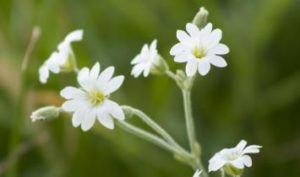

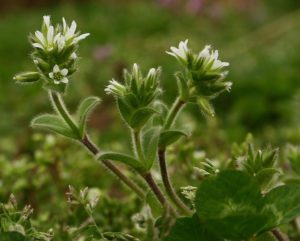

Real chickweed pictured here. If you hold up against the sun, you will see Stellaria media only has a single line of hairs down the stem,
Fake chickweed, also known as “mouse-eared chickweed”. (Cerastium sp.). If you hold mouse-eared chickweed up against the sun you will see it is hairy/fuzzy all over. They are identical in looks except the hair, but mouse-eared is not medicinal, nor would it be palatable.
Edibilty and Preparation: Similar to low-growing spinach, the greens can be quite gritty, so wash them well. Chop the tender tips coarsely. Chickweed is tasty enough to use as a salad base, or it can be added to lettuce with other wild freens, such as violet (Viola sororia and V. odorata), purple dead nettle (Lamium purpureum), winter cress (Barbarea vulgaris and B. verna) and dandelion (Taraxacum officinalis).
One of my favorite ways to prepare chickweed’s tender tasty leaves is in pesto. See the pesto article here!
We use this wild pesto to dress up pizza and pasta; additionally, we enjoy it as a dip for raw veggies and crackers.
Chickweed is easy to digest and nutrient-rich and thus is traditionally prepared as a first food after a long illness, stomach flu, or food poisoning. It also has a reputation as a diet herb and many people swear by it as an ally in weight loss. It is typically prepared as a tea for this purpose, although some people have reported good results with the tincture. It is a diuretic, and perhaps it helps with weight loss by optimizing cellular metabolism and digestion.
The fiber is a welcome addition to most Americans diet and like all leafy greens, chickweed bulks up a meal and provides plenty of vitamins and minerals, while adding a few healthy calories. According to John Kallas of the Institute for the Study of Wild Plants, chickweed is higher in iron and zinc than any of the commonly cultivated greens, such as spinach, collards, and kale. It has a fair amount of vitamin C (close to the level of collard greens) and a little less calcium than spinach.
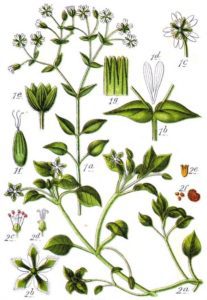

Medicinal Uses: Medicinally, chickweed is cooling and soothing, and anti-inflammatory. It is used topically in salves, herbal oils, poultices, and compresses. Internally, it can be taken as a tea, vinegar, food, or in capsules. Some of chickweeds nutritive qualities are wasted in tinctures the alcohol doesn’t extract minerals or mucilage; for this reason, I generally don’t recommend chickweed tincture.
It is considered a blood cleanser and a tonic, strengthening herb, especially after a long convalescence. Like other food-herbs, the upper dosage isn’t especially limited or finite, since you can literally consume the plant.
The high levels of iron in chickweed make it a powerful ally in iron-deficiency anemia: it can be ingested liberally as a food or in tea to help build blood.
Chickweed is safe to ingest while breastfeeding to help remedy postpartum anemia and fatigue and to increase breast milk production.
Chickweed tea is often recommended as a daily tonic, along with red clover (Trifolium pratense) and burdock (Arctium lappa and A. minus) for acne, psoriasis, and eczema. These herbs help to optimize elimination of metabolic by-products via the bile and intestines (through the aid of hepatic and digestive functions).
Chickweed is a moistening expectorant and can be used as a tea for dry, hacking coughs and for dryness in the lungs or throat.
Topically, chickweed is applied as a poultice, infused oil, or compress for a number of external conditions with its cooling, soothing, anti-inflammatory and anti-itching qualities.
To prepare a chickweed infusion, use three to five tablespoons of the dried herb per quart of boiling water and drink three cups a day. If you’re using fresh chickweed, double or triple the amount of plant material. The high levels of iron in chickweed make it a powerful ally in iron-deficiency anemia; it can be ingested liberally as a food or in tea to help build blood. Combine it with nettles (Urtica dioica) in tea or vinegar, along with the tincture or syrup of yellow dock (Rumex crispus) to help build iron levels.
Actions: Diuretic, demulcent, anti-inflammatory, expectorant, galactagogue, alterative, nutritive tonic, gentle laxative, and vulnerary
Energetics: Cooling and moistening
Cleavers...
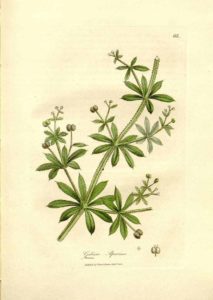

Cleavers is an interesting herb! Much like its comrade Chickweed, but this one has a unique characteristic in that it clings or (cleaves) to nearly everything in its reach. Perhaps how its became so widespread. Its scientific name- Galium aparine– is Greek for “milk seizer” referring to its folk use as a sieve for straining milk or its ability to seize passersby. Many plants in the Galium genus have been used to curdle milk in cheesemaking, as a vegetable rennet (in ancient Greek, gala signified milk).
Another cool fact about cleavers! You’ll often hear cleavers referred to colloquially (and historically) as “bedstraw”, as it was once a popular mattress stuffing that had a good reputation for holding its loft. Another common name is “goosegrass”, owing to the fact that cleavers is a favored food among foraging geese. It is equally relished by poultry, horses, cows, and sheep. However, be careful when feeding the plant to poultry, as it has caused problems in young chickens, presumably from gastric obstruction caused by the burr-like seeds.
This cosmopolitan weed has a legion of medicinal uses, both topically and internally. Cleavers is used to stimulate the lymphatic system and “cleanse” the blood. It is a traditional cancer remedy and historically was one of the main herbs Europeans used to treat tumors and cancerous sores, internally and externally, before the advent of chemotherapy and radiation. Cleavers is also used to help reduce swollen lymph nodes brought about by infection or stagnation.
Cleavers is prolific around the world, thanks to its fruitful evolution as an accomplished hitchhiker. With itsy-bitsy hooks on its stems, leaves, and seeds, cleavers has a Velcro like ability to cling to fur and fabric alike- and has thus been carried far and wide over the millennia. Cleavers is also able to cleave to neighboring plants, giving it the ability to prop itself up through sheer cling-power rather than investing in a woody stem of its own.
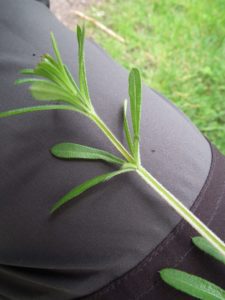

You might also say that cleavers gets around- botanically speaking, of course. As a foolproof reproductive strategy, its seeds, leaves, and stems are covered in dainty hooks, enabling it to cling to passersby who (with luck) will ferry it off to new and fertile ground. These hook-like bristles give cleavers a distinctly sticky feeling, and if you pick a stem or two, you’ll quickly notice how they cling to just about everything. Cleavers just make me smile!
Edibility and Preparation: Cleavers is a nutritive herb, and a classic one for spring cleansing. Its bristly nature makes it somewhat marginal as a pick-and-eat edible as the recurved (hooked) hairs can lodge the plant in your throat quiet uncomfortably. If you cook the plant long enough, it softens the hooked hairs, rendering them harmless.
Some people get around the bristliness by rolling a cleavers pill, as described above, or by only picking the tenderest of tips. But if you’re new to cleavers or just want to play it safe, you won’t run into problems by juicing or steaming the plant.
Cook the greens and use them in recipes as you would spinach. Cleavers has a stronger taste than many other wild greens. Intuitively, I feel it should be consumed in moderation-cook it as part of a meal, but not the main attraction. If you combine it with other spring greens, you’ll naturally be consuming a smaller amount. Cleavers is also phenomenal added to fresh pressed spring juices. You can mix and match any other herbs, fruits, or veggies of choice. The seeds of cleavers, dried and lightly roasted can be used as a caffeine-free substitute for coffee. I haven’t tried this, but the Great Plains Flora Association reports it as being “the best substitute for coffee in North America.”
See this article to learn how to make your own healthy Cleavers Omelet! So good and so yummy!
Medicinal Uses: Cleavers is well-known for its detoxifying and soothing actions and is used specifically as an alterative, anti-inflammatory, a lymphagogue, a diuretic, and a tonic herb. Cleavers doesn’t hold its vitality for long once it’s dried so use the dried herb quickly- as long as it’s green and vital looking, it should still be medicinally active.
It also isn’t the best herb for tincturing in alcohol because larger doses are called for and the herb’s minerals aren’t effectively extracted by the alcohol. It’s best suited for preparation as a juice, succus, and fresh infusion or as a topical remedy (salve, poultice, compress, or wash.)
Its alterative action makes it a valuable remedy for dry, itchy, and inflamed skin conditions such as eczema and psoriasis, It can also calm eruptive issues such as boils, and acne. Take as a tea (consider adding yellow dock or burdock) or apply topically as a poultice, wash or salve in cahoots with other skin-soothing herbs, like chickweed, violet and plantain.
Cleavers is a remarkable tonic for the lymphatic system and is especially helpful for treating acute, hot, red inflammations such as tonsillitis, laryngitis, mastitis (with redroot and Echinacea), and swollen glands. It is also indicated for several inflammatory childhood illnesses: chickenpox, mumps, and measles. Cleavers works its lymphatic magic by effectively relieving swelling, encouraging drainage and calming irritation.


Cleavers has a special affinity for the urinary tract and kidneys. A soothing diuretic, it delivers relief and healing for scant or painful urination, urinary tract infections and interstitial cystitis.
Cleavers is a traditional cancer and tumor remedy; it has long been used internally and topically to detoxify the body, stimulate drainage, and ease inflammation. Herbal healers in Wales have used the infusion of cleavers internally for this purpose for hundreds of years, as documented in a text by the Physicians of Myddfai written in 1743. Their recipes call for pounding the plant material and leaving it to soak in water overnight. The resulting infusion is taken fresh as the sole drink for nine weeks as a remedy for cancer, rheumatism, gout and edema. These same herbal physicians also used the juice of cleavers to heal cancer when it had destroyed the flesh to the bones.
Cleavers has a rich tradition as a springtime cleanser– a refreshing ritual that embraces the healing herbs of springtime and helps cleanse our bodies after the cold, slow months of winter.
Actions: Diuretic, alterative, lymphagogue, anti-inflammatory, gentle astringent, and hepatic
Energetics: Cooling and slightly drying through astringent and diuretic qualities
